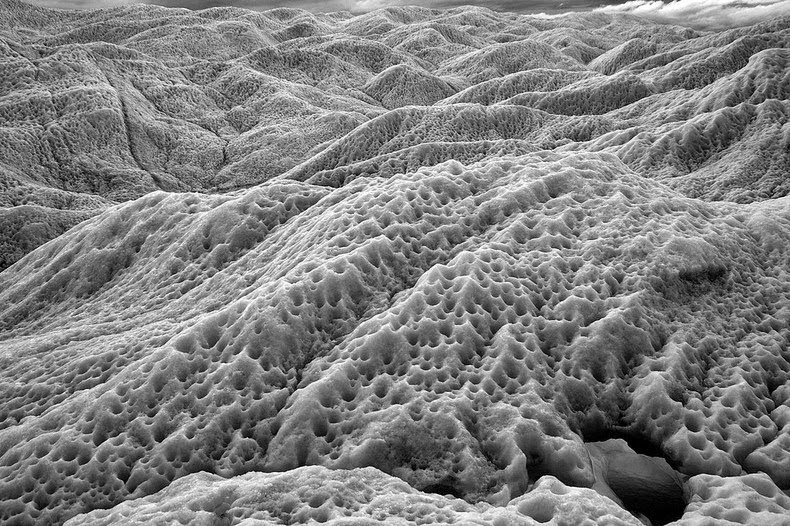Cryoconite Holes on Glaciers
Sometimes the surface of glaciers exhibit peculiar water filled cylindrical holes of varying sizes. At the bottom of these holes, there is usually deposits of dark colored sediments. The rest is filled with melt water. These are called cryoconite holes and are formed due to certain powdery windblown dust, called cryoconite. The name comes from the words “cryo” which means ice, and “conite” which means dust. It was first observed and explained by the Swedish explorer Nils A. E. Nordenskiöld when he traveled on Greenland's icecap in 1870.
Cryoconite dust is made of a combination of small rock particles, soot and microbes which is deposited and builds up on snow, glaciers, or icecaps. Cryoconite may contain dust from far away continental deserts or farmland, particles from volcanic eruptions or power plant emissions, and soot. These dark materials absorb heat from sunlight and causes the ice beneath them to melt, forming long cylindrical holes. As the cryoconite sinks it creates a black layer at the bottom while continuing to melt deep down into the ice.

The holes can vary in width and depth, typically ranging in diameter from 5 to 145 cm, and depths ranging from 4 to 56 cm. In some cases, huge holes as deep as 5 meters and up to 30 meters in diameters have been found.
During summer, cryoconite holes frequently contain liquid water and thus provide a nice environment for cold-adapted microorganisms like bacteria, algae and sometimes insects to thrive. Energy produced by these organisms further contribute to the growth of the holes. It has been suggested that cryoconite holes are individual ecosystems with distinct boundaries, energy flow, and nutrient cycling. In winter, an ice lid can form enclosing the inhabitants with a small amount of liquid water. When summer returns the lid melts and the colony continues to grow, year upon year.
When the glacier in which the cryoconites have formed begins to melt, the cryoconites melt away and disappear. The microbial communities that existed within them are then released and act like a 'seed population' to colonize the soil that has just been deglaciated.
Cryoconite holes are common to the ablation zone of glaciers worldwide, including the Arctic, temperate glaciers of the mid-latitudes and the Antarctic. They can also appear on sea ice and lake ice.


Photo: To The Poles

Photo: Mark Morgan

Photo: cmbellas

Side view of cryoconite holes that have melted out. Canada Glacier, McMurdo Dry Valleys, Antarctica. Photo credit: Andrew G. Fountain

Source: Amusing Planet
Cryoconite dust is made of a combination of small rock particles, soot and microbes which is deposited and builds up on snow, glaciers, or icecaps. Cryoconite may contain dust from far away continental deserts or farmland, particles from volcanic eruptions or power plant emissions, and soot. These dark materials absorb heat from sunlight and causes the ice beneath them to melt, forming long cylindrical holes. As the cryoconite sinks it creates a black layer at the bottom while continuing to melt deep down into the ice.

The holes can vary in width and depth, typically ranging in diameter from 5 to 145 cm, and depths ranging from 4 to 56 cm. In some cases, huge holes as deep as 5 meters and up to 30 meters in diameters have been found.
During summer, cryoconite holes frequently contain liquid water and thus provide a nice environment for cold-adapted microorganisms like bacteria, algae and sometimes insects to thrive. Energy produced by these organisms further contribute to the growth of the holes. It has been suggested that cryoconite holes are individual ecosystems with distinct boundaries, energy flow, and nutrient cycling. In winter, an ice lid can form enclosing the inhabitants with a small amount of liquid water. When summer returns the lid melts and the colony continues to grow, year upon year.
When the glacier in which the cryoconites have formed begins to melt, the cryoconites melt away and disappear. The microbial communities that existed within them are then released and act like a 'seed population' to colonize the soil that has just been deglaciated.
Cryoconite holes are common to the ablation zone of glaciers worldwide, including the Arctic, temperate glaciers of the mid-latitudes and the Antarctic. They can also appear on sea ice and lake ice.


Photo: To The Poles

Photo: Mark Morgan

Photo: cmbellas

Side view of cryoconite holes that have melted out. Canada Glacier, McMurdo Dry Valleys, Antarctica. Photo credit: Andrew G. Fountain

Source: Amusing Planet
Related Posts:
- No These Aren't Crop Circles, Wait Until You See What This Artist Does In The Snow.
- At First, It Looks Like Aliens Invaded Us. But Zoom Out And Learn The Truth… AMAZING.
- It Looks Like A Crazy Guy Just Walking Around In The Snow. Then You Zoom Out And.. Whoa.
- A Man Takes A Single Rake to The Beach… When You Zoom Out And See It’ll Blow Your Mind!
- Mind-Bending 3D Beach Art By NZ Artist Jamie Harkins
Cryoconite Holes on Glaciers
 Reviewed by Eli Snow
on
5:11 AM
Rating:
Reviewed by Eli Snow
on
5:11 AM
Rating:
 Reviewed by Eli Snow
on
5:11 AM
Rating:
Reviewed by Eli Snow
on
5:11 AM
Rating:

+-+This+is+Alaska's+Muir+Glacier+&+Inlet+in+1895.+Get+Ready+to+Be+Shocked+When+You+See+What+it+Looks+Like+Now..jpg)








No comments